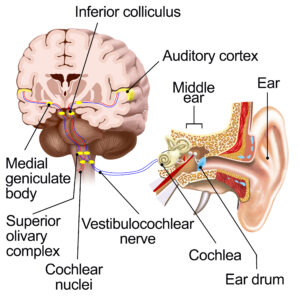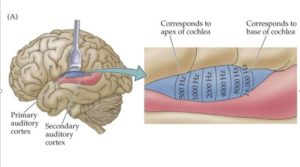

- Home
- Quick Reference Guide
When you are considering Sound Therapy, there are some things you need to decide.
This guide will help you through the process of deciding if this program is suitable for your condition, which package is right for you, and help you to understand what is involved in using it.
It will quickly answer your questions and point you to resources on our website to give you more details.
These are the main questions people ask when they are considering using Sound Therapy. Click on the question to get more details
How does it work?


Ear muscles – two tiny muscles in the middle ear are activated by the filtered music. Alternating high and low frequencies cause the muscles to alternately tense and relax, creating a gymnastic effect, just like taking your ears to the gym.
Auditory pathway – the entire auditory pathway from the ear to the brain, is gradually retrained by specific algorithms or patterns in the music so that the way sound is received by the brain is normalised.
Brain centres – at least ten different brain centres are impacted by the sounds we use, so that many different brain functions are enhanced.
Neural integration – the progressively filtered sound program creates connections between different parts of the brain so that our mental capacity and performance is improved.
Emotional balance – certain neural pathways are activated which automatically switch our emotional system into a positive, relaxed, trusting and uplifted state.
Learn more HERE
What are the benefits?


Natural hearing improvement - as an alternative or an adjunct to a hearing aid, Sound Therapy helps the natural ear to heal and perform better. Its like physiotherapy for the ears. This results in reduced tinnitus, better hearing in noisy environments, reduced dizziness, sound sensitivity or blocked ears.
Children and learning – for children struggling to learn, especially those with disabilities or learning difficulties, Sound Therapy accelerates their potential by normalising perception and ear-brain function.
Emotional and stress relief – with rates of stress, anxiety and depression sky-rocketing, Sound Therapy is the perfect, drug free solution to bring about inner peace and mental calm. It works by calming the nerves and activating brain centres which generate positive emotions.
Brain performance – Sound Therapy enhances focus, memory, creativity and mental performance by building and activating neural pathways, and by recharging the cortex of the brain with high frequency sound.
Learn more here:
Tinnitus and hearing
Children and learning
Emotional and stress relief
Brain performance
Where is the evidence?


Dr Tomatis – Sound Therapy is based on some key discoveries made by the French ENT doctor, Alfred Tomatis, about how the ears can be stimulated and healed, and how they function to activate and restore brain responses, emotional balance and integration of the nervous system.
Key discoveries – the Tomatic Effect was discovered by Tomatis and confirmed by the Sorbonne University in Paris in 1960. Brain plasticity was confirmed by Michael Merzenich in 2004. The neuro- physiological theory of tinnitus was developed by Jastreboff in 1996. Polyvagal theory was developed by Stephen Porges in 1995. These discoveries provide the scientific basis for how the Tomatis method works.
Published research papers – several hundred clinics and researchers have produced over a hundred clinical experiments and published papers, which verify the effects of Tomatis Sound Therapy.
Testimonials – thousands of Sound Therapy listeners have written about their successful results over the years. Many of these accounts can be found on our website.
Learn more here:
How do you use it?


The music – Sound Therapy uses classical music that has been specially filtered to activate the ears and brain. It sounds very much like a normal recording of classical music, but because of the filtering it has a profoundly healing effect on our ears, brain and nervous system.
Equipment – you listen on a purpose-made, small, portable player with earphones. All the equipment is provided with your purchase.
When to listen – You can listen during any activity, including exercise, reading, working, having a conversation, watching TV or sleeping. The volume is low and there is no need to pay attention to the music. It is not distracting.
Listening time – the recommended listening time is about three hours per day, and this can be broken up however you wish. However, it takes no time out of your day, as you listen during your normal activities, or even during sleep.
Listening Routine – each person will follow a specific listening routine as set out in their workbook. Your routine depends on your level of auditory sensitivity.
Duration - most people experience some benefits in the first few days and greater results in the first few weeks, with the average time being three to six months. However, many choose to keep listening for many years, due to the added benefits of enhanced mental and physical wellbeing.
What does it cost?


Cost effective solution – the cost of Sound Therapy compares favourably with other options such as hearing aids, clinical Sound Therapy treatment or ongoing practitioner fees.
Most affordable solution – Sound Therapy International has always had the mission of offering programs that are affordable, portable and convenient. You are provided with books, workbooks and email support so that you can become your own therapist. Having the knowledge to supervise your own listening, saves you thousands of dollars, compared to other programs.
Different options – our programs start at $699.00 with payment options of $128.00 per month. Additional discounts are offered from time to time. Most people listen for 6 to 12 months minimum, which works out at average 0.87c per hour. After listening for three years this becomes 0.29c per hour, with no further outlay.
One off cost – when you purchase a Sound Therapy program, you then own the program and the equipment and there are no further ongoing payments to keep listening.
Ongoing support – as a Sound Therapy listener you receive ongoing clinical and technical support via phone and email to ensure you can obtain the full benefits of your program.
Advanced programs – There are advanced programs available for purchase after three months of listening. This is an optional choice for those who wish to take their listening to the next level.
Replacement upgrades – when your equipment eventually fails, you can purchase an upgrade to the latest equipment with the same music program, for a nominal fee. This means that while you pay for the equipment upgrade, you do not have to pay for the therapy again.
The cost is less than what you would have paid if you were regularly replacing batteries.
Learn more here:
What equipment do I need?


The Sontegrity music player. Sound Therapy programs come pre-loaded on a purpose-made, convenient, portable player that is not much bigger than a matchbox. It produces very high fidelity sound to ensure the success of the therapy. It comes with a charger and rechargeable battery.
Headphones. The program includes headphones and a charger. Any good quality headphones can be used for Sound Therapy. We offer a range of styles which are portable, durable and deliver high quality audio. All our headphones are wired, to ensure the best high frequency audio signal.
Learn more here:
Which program should I choose?


New listeners can choose from three packages, depending on the severity of your condition and your available funds.
The Basic Essentials gives you everything you need to do the program: The player, headphones, book, workbook and email and hone support.
The Triple Mode package has all the basics plus two additional high quality headphones and a set of Nutrition for the Ear, to help you achieve better results.
The Deluxe package includes all of the above plus a Level two program, which you can begin using after three months on Level one, so it is two programs in one.
For children we have special children’s programs with stories and music combined, and the Family Program includes three players and five headphones, making it the best option for families.
Learn more here:
Is my condition serious enough to warrant treatment?


When people say “my tinnitus isn’t very bad, so I’ll just live with it” they are making a mistake. Leaving it until it gets worse makes it much harder to treat. Re-wiring the audio-neural pathways can be done, but it requires consistent retraining, and the sooner you start, the greater your chance of success.
Nowadays, everyone is concerned about brain health as we get older. In order to maintain an active brain with well integrated pathways and good memory, we need regular sensory stimulation. Sound Therapy easily provides this, giving us an effortless system to help maintain ear and brain health for life. You don’t have to have a problem to use it—you just have to have a brain!
So if you want to ensure the best possible hearing as you get older, and to keep your brain healthy and firing on all six cylinders, contact us now to get started on this easy and enjoyable self-help program. We look forward to welcoming you to our community of happy Sound Therapy listeners, and hearing of your great results.
